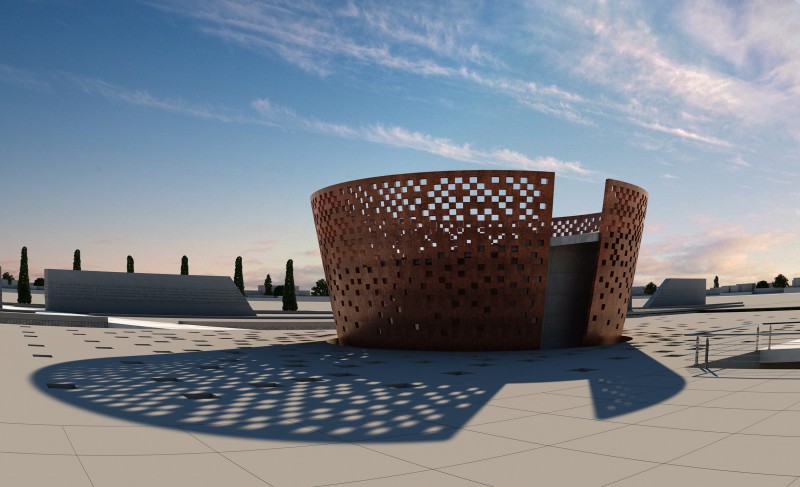Shams Tabrizi Monument in Khoy designed by Farshad Kazerooni, Azin Soltani, Farnaz Bakhshi.










Name: Shams Tabrizi Monument
Location: Shams Tablizi Blvd. Khoy, West Azerbaijan province, Iran
Architect firm: BNS Co. (Bahambar Novin Saz)
Architects in charge: Farshad Kazerooni, Azin Soltani, Farnaz Bakhshi
Design Team: Anahita Ali Asgarian, Mandana Fouladi, Yasaman Sepahsalari, Azadeh Farajpour, Zoha Nekouian, Hanieh Kazerooni
Date of design: 2013
Site area: 7300 sqm
Project Area: 2000 sqm
Building Type: Cultural, Monumental
3D renders: Ali Zeinalzadeh
Model: BNS Co.
Graphic: Golnaz Jamshidi, Niloufar Ghorbani
Awards:
- Winner of Community and Cultural Project of the Year, Middle East Architect Awards 2014
- Winner of International Architecture Awards 2015
The project located in Khoy city (in the west Ajarbaiejan province of Iran). According to the program which is given, this building is not only a Monument but also a cultural center which are included different parts like: galleries, library, research center, Amphitheatre and actually the main space for Shams Tomb and Sema ceremony. Chosen site for designing Shams Monument was an historical area included Shams Minaret and ancient cemetery which we haven’t any permission to build any building in this part. Landscape of Shams memorial designed in a way to communicate with all ages. The aim of design is to teach visitors in all ages about the history of city, spiritual personality of Shams and his influence on people awareness about life while experiencing different part of the site.
Historical researches which were conducted on the city of Khoy and the chosen site concluded that this part of the city encompassed gardens and agricultural lands which – as a result of urban expansions –has been replaced by streets and residential areas. This fact triggered the idea of reusing linear geometry and square strips of agricultural fields in designing the site to revive its historical background.
Thus the Shams Monument was designed in form of a garden-tomb, making it possible for visitors to roam around while at the same time the Shams’ Minaret would symbolize part of the city’s historical identity. Using rows of cedar trees and memorial walls on both sides of Shams Boulevard emphasizes on creating a totally different atmosphere for passersby. The monument building has two skins. The outer skin is a circular perforated copper wall while the interior is a solid concrete wall. The spiral ramp comes throughout these two layers of walls to the site. In the middle of monument is a spiritual place where visitors can sit in silence and think about themselves.
Shams Monument is an introspective building sinking into the ground to create a vaster garden-tomb while having the territory in mind. By creating sunken gardens around the building, not only the amount of light going inside the building could be managed but also it will cause the monument to stand out and get separated from the site.
Given the program of the project, the Monument has been divided into three parts each consisting of a 24 by 24 (m) square, the squares are connected to one another through the connecting parts. The three design principles of Persian architecture (sequence, axis and symmetry) have been used in designing this Monument, the middle square (the tomb) showcases these principles more than the others.
In designing this part, the attempt was to ascend from the material world to a spiritual one by resigning of worldly attachments: a movement from the square (symbol of the earth and the corpus) to the circle (symbolizing the sky and the spirit); to achieve this goal, chahar taq architecture (Persian meaning: four arches) has been applied which is the most prominent element in traditional Iranian architecture after the ayvān ; the created space possesses dual characteristics like Shams: ambiguous and clear, complicated and simple at the same time.
With the circular movement through the spiral ramp which is located in the center of tomb space will reminds sufi's sacred dance to visitors standing at the tomb level. “While Sufis are whirling, his arms are open: his right arm is directed to the sky, ready to receive God's beneficence; his left hand, upon which his eyes are fastened, is turned toward the earth. The semazen conveys God's spiritual gift to those who are witnessing the Sema. Revolving from right to left around the heart, the semazen embraces all humanity with love. The human being has been created with love in order to love.
At night the dynamics of the Monument is maintained by using the functionality of various parts of the building at different hours as well as symbolic lighting of the building and the movement of light from the middle part of the building towards the sky, all contributing to keep the Monument filled with life at all time.




